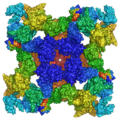Ryanodine receptor
Ryanodine Receptor
The Ryanodine Receptor (RyR) is a class of intracellular calcium (calcium) channels across various types of cells, playing a crucial role in the calcium signaling pathway. These receptors are named after ryanodine, a plant alkaloid that binds to these receptors with high affinity. Ryanodine receptors are essential for the process of muscle contraction, facilitating the release of calcium from the sarcoplasmic reticulum into the cytoplasm in muscle cells. There are three main isoforms of the receptor found in mammals, designated as RyR1, RyR2, and RyR3, each encoded by a separate gene and having distinct tissue distribution and functional roles.
Structure and Function[edit]
Ryanodine receptors are large homotetrameric complexes, with each subunit consisting of more than 5000 amino acids, making them among the largest known ion channels. The structure of RyR is characterized by a large cytoplasmic domain, which acts as a regulatory platform, and a smaller transmembrane domain that forms the ion channel. The receptors are activated by various stimuli, including electrical excitation, binding of calcium ions, and interaction with other regulatory molecules such as calmodulin and FKBP12.
The primary function of RyR is to mediate the rapid release of calcium from the sarcoplasmic reticulum into the cytoplasm, a process critical for muscle contraction. In cardiac and skeletal muscles, this calcium release triggers muscle contraction through the excitation-contraction coupling mechanism. In other cell types, RyR-mediated calcium release plays essential roles in various cellular processes, including gene expression, metabolism, and cell death.
Clinical Significance[edit]
Mutations in the genes encoding the Ryanodine Receptor can lead to several diseases, collectively known as RyRopathies. These include malignant hyperthermia (MH), a life-threatening condition triggered by certain anesthetics and muscle relaxants, and various forms of cardiomyopathy and arrhythmia associated with mutations in RyR2. Additionally, alterations in RyR function have been implicated in neurodegenerative diseases, such as Alzheimer's disease, due to disrupted calcium homeostasis.
Pharmacology[edit]
Given its central role in muscle contraction and calcium signaling, the Ryanodine Receptor is a target for drugs that modulate its activity. Ryanodine itself, while not used therapeutically due to its toxicity, has been invaluable in studying RyR function. Dantrolene, a drug used to treat malignant hyperthermia, acts by inhibiting the RyR1 receptor, demonstrating the therapeutic potential of targeting RyR pathways.
Research Directions[edit]
Research on Ryanodine Receptors continues to uncover their complex regulation and the diverse roles they play in health and disease. Advances in structural biology have provided detailed insights into the receptor's architecture, opening up new avenues for the development of drugs targeting specific RyR isoforms. Understanding the intricate regulation of RyR and its interaction with other cellular components remains a significant challenge, with implications for treating diseases associated with RyR dysfunction.
| Cell signaling: calcium signaling and calcium metabolism | ||||||||||||||||||||
|---|---|---|---|---|---|---|---|---|---|---|---|---|---|---|---|---|---|---|---|---|
|
| Protein: cell membrane proteins (other than Cell surface receptor, enzymes, and cytoskeleton) | ||||||||||
|---|---|---|---|---|---|---|---|---|---|---|
|
Ryanodine receptor gallery[edit]
-
Ryanodine
-
Coupling of the muscle action potential to Ca++ release from the sarcoplasmic reticulum - the dihydropyridine receptor and ryanodine receptor
-
Ryanodine Receptor 2
Ad. Transform your life with W8MD's Budget GLP-1 injections from $75


W8MD offers a medical weight loss program to lose weight in Philadelphia. Our physician-supervised medical weight loss provides:
- Weight loss injections in NYC (generic and brand names):
- Zepbound / Mounjaro, Wegovy / Ozempic, Saxenda
- Most insurances accepted or discounted self-pay rates. We will obtain insurance prior authorizations if needed.
- Generic GLP1 weight loss injections from $75 for the starting dose.
- Also offer prescription weight loss medications including Phentermine, Qsymia, Diethylpropion, Contrave etc.
NYC weight loss doctor appointmentsNYC weight loss doctor appointments
Start your NYC weight loss journey today at our NYC medical weight loss and Philadelphia medical weight loss clinics.
- Call 718-946-5500 to lose weight in NYC or for medical weight loss in Philadelphia 215-676-2334.
- Tags:NYC medical weight loss, Philadelphia lose weight Zepbound NYC, Budget GLP1 weight loss injections, Wegovy Philadelphia, Wegovy NYC, Philadelphia medical weight loss, Brookly weight loss and Wegovy NYC
|
WikiMD's Wellness Encyclopedia |
| Let Food Be Thy Medicine Medicine Thy Food - Hippocrates |
Medical Disclaimer: WikiMD is not a substitute for professional medical advice. The information on WikiMD is provided as an information resource only, may be incorrect, outdated or misleading, and is not to be used or relied on for any diagnostic or treatment purposes. Please consult your health care provider before making any healthcare decisions or for guidance about a specific medical condition. WikiMD expressly disclaims responsibility, and shall have no liability, for any damages, loss, injury, or liability whatsoever suffered as a result of your reliance on the information contained in this site. By visiting this site you agree to the foregoing terms and conditions, which may from time to time be changed or supplemented by WikiMD. If you do not agree to the foregoing terms and conditions, you should not enter or use this site. See full disclaimer.
Credits:Most images are courtesy of Wikimedia commons, and templates, categories Wikipedia, licensed under CC BY SA or similar.
Translate this page: - East Asian
中文,
日本,
한국어,
South Asian
हिन्दी,
தமிழ்,
తెలుగు,
Urdu,
ಕನ್ನಡ,
Southeast Asian
Indonesian,
Vietnamese,
Thai,
မြန်မာဘာသာ,
বাংলা
European
español,
Deutsch,
français,
Greek,
português do Brasil,
polski,
română,
русский,
Nederlands,
norsk,
svenska,
suomi,
Italian
Middle Eastern & African
عربى,
Turkish,
Persian,
Hebrew,
Afrikaans,
isiZulu,
Kiswahili,
Other
Bulgarian,
Hungarian,
Czech,
Swedish,
മലയാളം,
मराठी,
ਪੰਜਾਬੀ,
ગુજરાતી,
Portuguese,
Ukrainian


